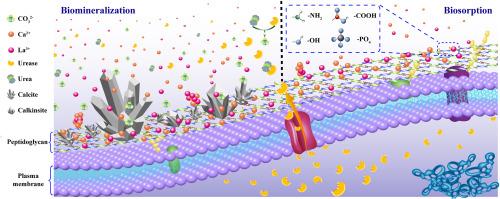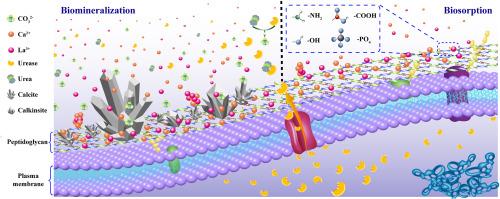Ureolytic Nocardia tenerifensis-driven carbonate precipitation for enhanced La3+ adsorption and immobilization
IF 9.7
1区 环境科学与生态学
Q1 ENGINEERING, ENVIRONMENTAL
引用次数: 0
Abstract
Rare earth elements (REEs) are essential in numerous modern industries, yet their extraction presents significant environmental challenges. Sustainable recycling technologies for REEs are therefore crucial for both environment protection and resource conservation. Microbially induced calcite precipitation (MICP) offers a promising solution. This study focused on a high urease activity (216.5 U/mL), lanthanum-tolerant (400 mg/L) strain, Nocardia tenerifensis KLBMP 9777. Ca2+ addition during the MICP process significantly alleviated the La3+ toxicity and enhanced mineralization. The maximum removal rate of La3+ increased from 66.2% to 89.1%, while the urease activity also increased from 80.7 U/mL to 101.7 U/mL. Scanning electron microscope (SEM) and X-ray energy dispersive spectroscopy (EDS) revealed the formation of needle-like and rhombic crystal structures after mineralization. Fourier transform infrared spectroscopy (FTIR) and X-ray photoelectron spectroscopy (XPS) identified carboxyl, amino, carbonyl, and carbonate groups as key players in the MICP-mediated La3+ adsorption. Further analysis by X-ray diffraction (XRD), Transmission electron microscopy (TEM), and Thermogravimetry-derivative thermogravimetry analyses (TG/DTG) confirmed that the mineral deposits on the cell surface were calkinsite (La2(CO3)3·4H2O) and calcite (CaCO3). The findings advance our understanding of the MICP mechanism and provide a theoretical foundation for its application in REEs recovery and environmental remediation.


特内里费岛尿素分解诺卡氏菌驱动碳酸盐沉淀以增强对 La3+ 的吸附和固定作用
稀土元素(REEs)是众多现代工业中不可或缺的元素,但其提取却给环境带来了巨大挑战。因此,稀土元素的可持续回收技术对于环境保护和资源节约都至关重要。微生物诱导方解石沉淀(MICP)提供了一种前景广阔的解决方案。本研究以高脲酶活性(216.5 U/mL)、耐镧(400 mg/L)菌株 Nocardia tenerifensis KLBMP 9777 为研究对象。在 MICP 过程中添加 Ca2+ 可显著减轻 La3+ 的毒性并提高矿化度。La3+ 的最大去除率从 66.2% 提高到 89.1%,脲酶活性也从 80.7 U/mL提高到 101.7 U/mL。扫描电子显微镜(SEM)和 X 射线能量色散光谱(EDS)显示矿化后形成了针状和菱形晶体结构。傅立叶变换红外光谱(FTIR)和 X 射线光电子能谱(XPS)确定了羧基、氨基、羰基和碳酸盐基团是 MICP 介导的 La3+ 矿化过程中的主要角色。通过 X 射线衍射 (XRD)、透射电子显微镜 (TEM) 和热重-衍生热重分析 (TG/DTG)进行的进一步分析证实,细胞表面的矿物沉积物是白垩岩(La2(CO3)3-4H2O)和方解石(CaCO3)。这些发现加深了我们对 MICP 机制的理解,并为其在稀土元素回收和环境修复中的应用提供了理论基础。
本文章由计算机程序翻译,如有差异,请以英文原文为准。
求助全文
约1分钟内获得全文
求助全文
来源期刊

Journal of Cleaner Production
环境科学-工程:环境
CiteScore
20.40
自引率
9.00%
发文量
4720
审稿时长
111 days
期刊介绍:
The Journal of Cleaner Production is an international, transdisciplinary journal that addresses and discusses theoretical and practical Cleaner Production, Environmental, and Sustainability issues. It aims to help societies become more sustainable by focusing on the concept of 'Cleaner Production', which aims at preventing waste production and increasing efficiencies in energy, water, resources, and human capital use. The journal serves as a platform for corporations, governments, education institutions, regions, and societies to engage in discussions and research related to Cleaner Production, environmental, and sustainability practices.
 求助内容:
求助内容: 应助结果提醒方式:
应助结果提醒方式:


